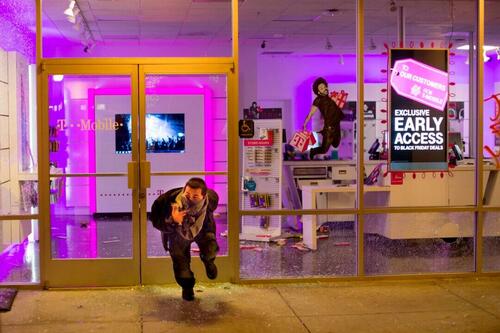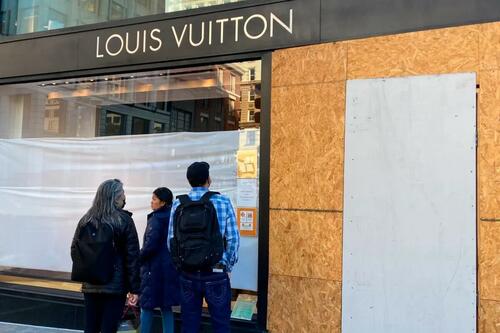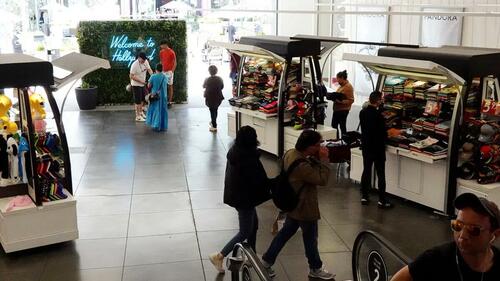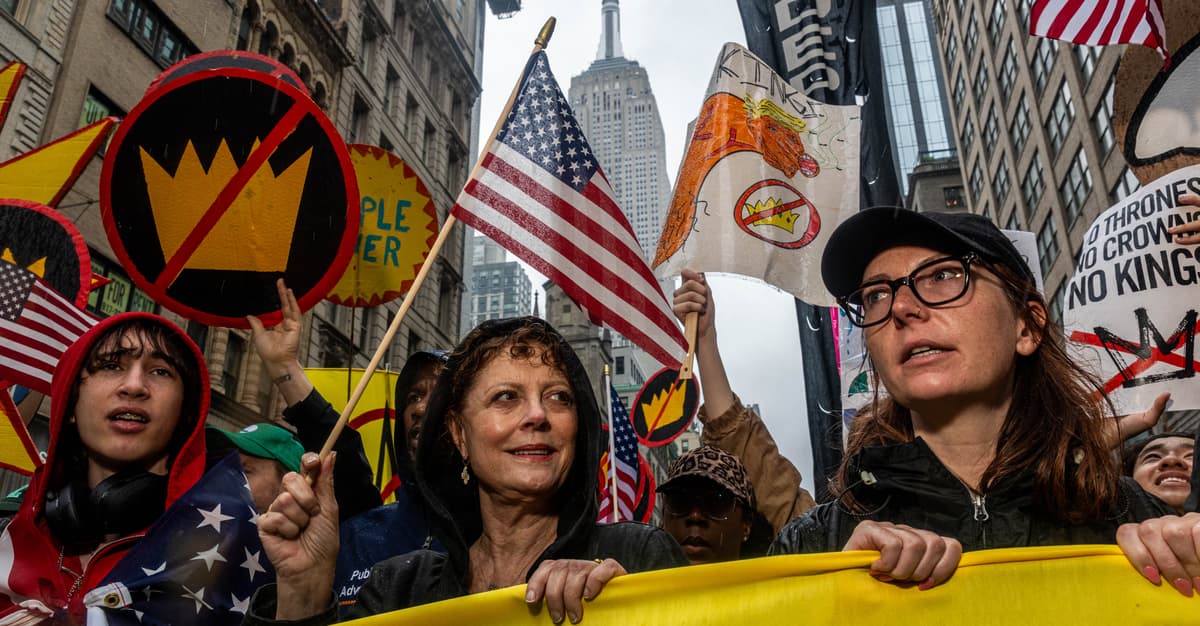
California Retail Theft Rose 11 Percent From 2014 To 2023: Report
Authored by Jill McLaughlin via The Epoch Times (emphasis ours),
California’s soft-on-crime approach, along with pandemic-era actions, may have contributed to a rise in retail theft from 2014 to 2023, according to a report published by the state Legislative Analyst’s Office (LAO) on June 12.
 A man with a face covering flees a T-Mobile store in Oakland, Calif., on Nov. 25, 2014. Noah Berger/AP Photo
A man with a face covering flees a T-Mobile store in Oakland, Calif., on Nov. 25, 2014. Noah Berger/AP PhotoIn the report, “Retail Theft in California: Looking Back at a Decade of Change,” the LAO found that retail theft in the state rose after a slight decline during the COVID-19 pandemic, resulting in an overall increase of 11 percent during the nine-year timeframe.
Despite the statewide increase, however, the numbers reported are still below the historical highs seen in the 1980s, the report found.
“Concerns about theft from retail businesses have become more prominent in recent years,” the analyst’s office wrote in the report. “Retail theft has implications for economic outcomes, as well as a sense of safety, well-being, and fundamental quality of life for Californians.”
In 2021, nearly two in three California voters said crime in the state was getting worse, while 23 percent said it was staying the same and 6 percent said it was getting better, according to a survey conducted that year by David Binder Research.
The report finds that the statistics have fluctuated greatly in the past decade.
From 2014 and 2015, retail theft increased slightly, going up 5 percent before declining 20 percent during 2015 and 2012. Nearly half of the drop happened between 2019 and 2020, when the state was placed on lockdown during the pandemic.
“Pandemic-related factors—such as temporary stay-at-home orders and closure of nonessential retail businesses in the early part of the pandemic—likely contributed to the decline over this period,” the report stated.
After the decline, statistics show that retail crime increased by 32 percent from 2021 and 2023.
The crime numbers may not represent the full picture, however, according to the analysis.
A large portion of law enforcement agencies—representing about 10 percent of the state’s population—did not report crime numbers for some or all of 2023 when reporting methods were changed nationwide during the Biden administration..
“Accordingly, crime data may understate the actual increase in retail theft that occurred in 2023,” the report stated.
Bucking the trend were smaller counties in the state that were reporting declines in retail theft from 2019 to 2023.
 Union Square visitors look at damage to a Louis Vuitton store in San Francisco on Nov. 21, 2021. Danielle Echeverria/San Francisco Chronicle via AP
Union Square visitors look at damage to a Louis Vuitton store in San Francisco on Nov. 21, 2021. Danielle Echeverria/San Francisco Chronicle via AP“The reason for these differences is unclear but could be tied to factors such as the concentration of retail establishments in each county,” according to the report.
The analysis pointed to Proposition 47, passed in 2014, and changes in the state’s criminal justice system after 2020 as possible reasons for crime to have risen. The proposition reduced several felonies to misdemeanors, limiting the authority to arrest people for some crimes.
The public has criticized the proposition, claiming the law allowed shoplifters to walk away with up to $950 in goods, mandating law enforcement to issue a ticket to suspected thieves instead of arresting them.
“Researchers found that Proposition 47 increased larceny (a category of crime that includes some forms of retail theft), though they were unable to determine the impact on retail theft specifically,” the analyst’s office, which provides fiscal and policy advice to the state Legislature, stated in the report’s executive summary.
 Shoppers browse in a Hollywood mall in Los Angeles on Oct. 26, 2023. Mario Tama/Getty Images
Shoppers browse in a Hollywood mall in Los Angeles on Oct. 26, 2023. Mario Tama/Getty Images“Generally, research on crime rates suggests that people are less likely to commit a crime when they perceive that they have a higher chance of being apprehended,” according to the report.
The state also changed several crime policies in response to the COVID-19 health crisis, including releasing convicted criminals early from prison, implementing zero-bail policies, and reducing probation term lengths.
“[Researchers] found that pandemic-era changes to the criminal justice system increased nonresidential burglary (a measure of some forms of retail theft) by reducing jail populations and the likelihood of arrest,” according to the LAO. “However, the researchers were only able to explain about one-third of the pandemic-era increase in nonresidential burglaries.”
The findings suggested that factors outside the criminal justice system, such as changes in the retail environment, also likely contributed to retail theft trends in California.
Possible changes to the retail environment may also have affected retail theft rates, the report said. For example, many stores have expanded shelf-checkout lines and store policies that direct staff not to physically confront shoplifters.
 A customer uses a self-checkout lane at a Home Depot store in San Rafael, Calif., on July 25, 2023. Justin Sullivan/Getty Images
A customer uses a self-checkout lane at a Home Depot store in San Rafael, Calif., on July 25, 2023. Justin Sullivan/Getty ImagesPandemic-era changes, such as the use of protective face masks that could also be used to conceal identities, may have further emboldened shoplifters, according to the analysis.
The report also stated that a change in societal factors, such as homelessness prompting the stealing of necessities like food, and increased drug use disorders, could have impacted retail theft rates.
Voters responded last year to the state’s growing retail theft problem, passing Proposition 36 and various other bills, including Assembly Bill 2943, which made it a crime for anyone to possess stolen property that was acquired through shoplifting, theft, or burglary. The bill also allows prosecutors to aggregate thefts in different counties to charge suspects with more severe crimes.
The changes have bolstered the ability of law enforcement to arrest and detain shoplifters, elevated retail theft from a misdemeanor to a felony in some cases, increased punishment for retail crime, and broadened the capacity to detect and respond to retail crime, the report stated.
“This change could also make it more likely for people to be arrested, given that law enforcement generally has greater authority to arrest people for felonies,” according to the report. “This, in turn, could help deter people from engaging in retail theft if it causes them to perceive a higher likelihood of apprehension.”
State and local law enforcement also implemented several programs to target organized retail crime in the past three years.
In March, Gov. Gavin Newsom reported the state’s Organized Retail Crime Task Force had conducted 879 investigations, leading to 1,707 arrests and the recovery of 676,227 stolen goods valued at $13.5 million.
“As public safety continues to be a priority for California, this ongoing retail theft crackdown shows the continuous work of our strengthened efforts on organized crime,” Newsom said in March.
The analysis recommends that legislators ask several key questions to provide oversight of recently passed laws.
The questions include asking whether officials are using the new crime-fighting tools available to them, and to report whether the new laws are resulting in a decrease in crime.
Overall, the analysis showed that while retail theft has increased in the state, the latest available numbers remain below historical levels.
From 1985 to 2023, the retail theft rate declined by 54 percent. A similar decline was recorded for all types of property crime during that time, including residential burglary and motor vehicle theft.
Tyler Durden
Sat, 06/14/2025 – 19:50














